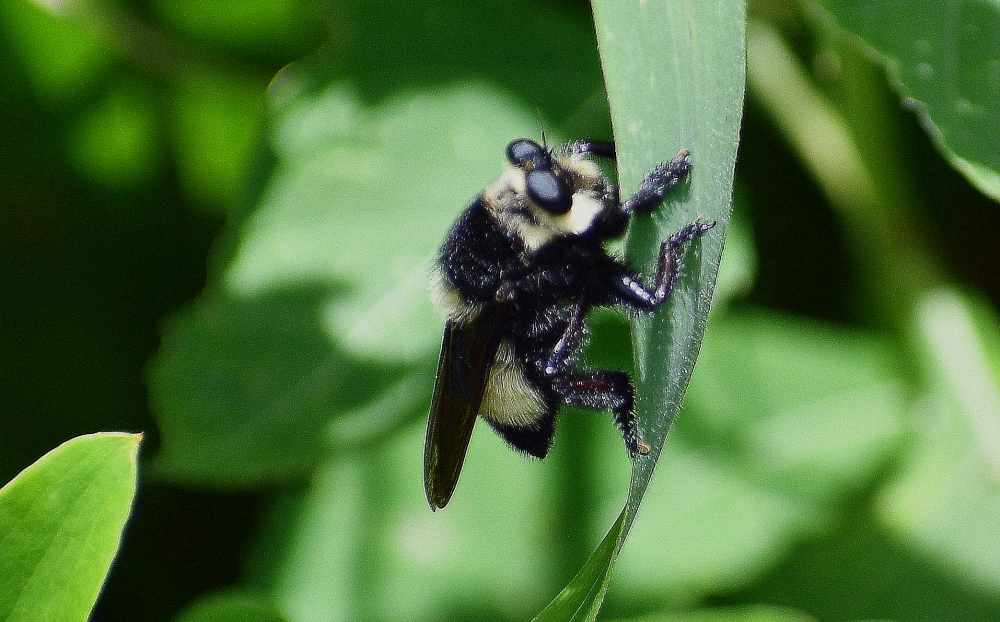
Southern bee killer (Terry W. Johnson)
By Terry W. Johnson
Recently I spotted an insect I assumed was a bumblebee perched on a blade of grass. Since bumblebees are among some of our most industrious insects, I thought it was strange that the bumblebee was not collecting nectar and pollen. When I leaned over and took a closer look, it was obvious this was not a bumblebee at all; it was a southern bee killer.
The southern bee killer (Mallophora orcina) is one of some 1,000 species of robber flies that inhabit North America. Over the years, I have seen a number of robber flies. Most are drab and look very much like large, hunch-backed, long-legged houseflies. All have large eyes that seem to face sideways. Their faces are covered with bristles. The fearsome-looking insects also share one additional trait – a sharp, knife-like proboscis.
But the robber fly I found was quite different. Its fuzzy body was marked with bold yellow and black bands, giving it the appearance of a bumblebee. The southern bee killer is a true bumblebee mimic. As such, some researchers believe predators that don't want to contend with the sting of a bumblebee, don't try to make a meal out of a southern bee killer. Who knows?
At any rate, like other robber flies, the southern bee killer is a consummate hunter. It perches on a twig, grass blade or other structure and waits for prey to fly by. While other robber flies dine on a wide variety of flying insects, the southern bee killer specializes in capturing paper wasps, carpenter bees, honeybees and, of course, bumblebees.
Once it spots one of these unsuspecting insects, it launches itself into the air and tries to chase it down. More often than not, it uses its long, powerful legs to latch onto its prey in mid-air. Once it grabs a bee, it drives its dagger-like beak deep into the animal's thorax or head and injects it with a lethal concoction of digestive enzymes and neurotoxins. This deadly brew quickly renders its prey helpless. In a matter of minutes, the potion literally liquefies the bee's body tissues.
Once the predator secures its meal, it returns to a perch and slurps up the remains of the insect. As soon as it has finished its meal, the southern bee killer discards the exoskeleton of its prey and awaits another victim.
Much to the chagrin of beekeepers, a southern bee killer will sometimes establish a hunting territory close by a beehive. This allows the hunter to dine on the steady stream of worker bees that fly in and out of the hive throughout the day.
If you happen to spot a southern bee killer perched on a plant in your garden, chances are, if you revisit the location another day, you will see this deadly predator waiting for its next meal. In addition, if you search the ground beneath its perch, you might even find the remains of former meals.
Thank goodness the southern bee killer does not attack humans. However, should you accidentally grab one; it can inflict a painful bite.
The next time you spot what appears to be a bumblebee hanging out in your garden on a hot, humid summer day, I urge you to take a second look: It might not be a bumblebee at all. It just might be one of Georgia's most accomplished aerial predators, the southern bee killer. It is another example of the remarkable insects you can often find in your backyard if you take the time to look.
Terry W. Johnson is a retired Nongame program manager with the Wildlife Resources Division and executive director of The Environmental Resources Network, or TERN, friends group of the division’s Nongame Conservation Section. (Permission is required to reprint this column.) Learn more about TERN, see previous “Out My Backdoor” columns, read Terry’s Backyard Wildlife Connection blog and check out his latest book, “A Journey of Discovery: Monroe County Outdoors.”




















